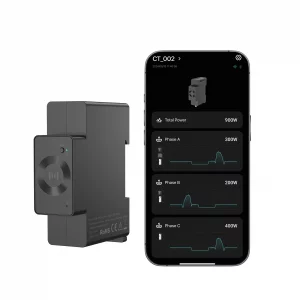DIY: Key Components for Home Solar & Energy Storage
This DIY guide describes four core devices commonly used in small residential solar and hybrid systems: the SQ8W-100 automatic transfer switch (ATS), Marstek Jupiter (E / C) energy storage units, Marstek Venus inverters / AC-coupled batteries, and the Marstek CT002 smart meter. Each section explains what the device does, gives short technical highlights and suggests typical DIY applications. Keywords: DIY solar, home energy storage, solar battery, MPPT controller, solar inverter, automatic transfer switch, zero-feed-in.
SQ8W-100 — Automatic Transfer Switch (ATS)

Purpose: an ATS automatically switches your household supply between the main grid and an alternative power source (inverter/generator/battery) when a loss or return of mains is detected — essential for safe, uninterrupted backup power.
Key specs (typical ranges):
- Rated operating voltage: AC 230 V / AC 400 V (models for single- and three-phase).
- Available nominal currents: 6 A – 63 A (common variants), with PV/ATS models offered up to 100 A in some suppliers.
- Insulation and short-circuit ratings: Ui up to 690 V, breaking capacity in kA range.
- Switching time: typically well under a few seconds (model dependent).
DIY applications: automatic changeover for a small hybrid panel + battery system, safe isolation of loads during maintenance, or automatic activation of inverter backup when mains fail. Always have an electrician check ATS wiring and compliance with local regulations.
Marstek Jupiter (Jupiter E / C) — All-in-One Energy Storage Unit

Purpose: compact all-in-one battery energy storage systems (ESS) designed for balcony or small home use: they combine battery cells, power electronics and PV/battery management for easy plug-and-play or semi-integrated DIY installs.
Key specs:
- Typical capacities: 2560 Wh and 5120 Wh variants.
- PV input: 4 MPPT design supporting up to ~2000–2400 W PV input (model dependent).
- AC output / on-grid support: ~800 W on-grid continuous output on smaller variants; IP65 and wide operating temperature ranges on several models.
DIY applications: balcony ESS for self-consumption, small hybrid systems where you want an integrated battery plus PV input, or modular expansion (stacking multiple units) to increase capacity. Jupiter units are ideal as a first step into home storage because of their compact, user-friendly design.
Marstek Venus — Inverter / AC-Coupled Battery Systems

Purpose: Venus products are plug-and-play inverter + battery solutions (and separate inverter models) that convert DC from PV/batteries into AC for household loads, support backup power and often allow bidirectional AC charging/discharging.
Key specs & features:
- Power & capacity: models range from small plug-in units up to multi-kW systems; example Venus units offer ~2.2–2.5 kW bidirectional power and backup outputs, with battery variants at 2.56 kWh – 5.12 kWh (expandable).
- Solar input: 4 MPPT on many models, supporting up to ~2.4–4.0 kW solar input depending on the version.
- Functions: plug-and-play installation, EPS/backup with short transfer times (e.g. <15 ms on some units), anti-feed-in/self-consumption modes, app monitoring and multi-unit expansion. Many Venus units carry a 10-year warranty on battery modules.
DIY applications: AC-coupled home battery to increase self-consumption, plug-in battery backup for critical circuits, or a scalable modular system (add more Venus units to grow capacity).
Marstek CT002 — Smart Meter / Energy Sensor

Purpose: CT002 is a compact smart meter and power sensor used to measure real-time consumption and export. It feeds data to Marstek inverters/ESS to enable modes such as zero-feed-in (anti-export), self-consumption optimisation and load prioritisation.
Key specs:
- Measurement: voltage range 100–260 V; current measurement typically up to 100 A per phase; voltage & current accuracy around ±1% in normal ranges.
- Communications: Wi-Fi (2.4 GHz) and Bluetooth for integration with the Venus/Jupiter ecosystem and mobile apps.
- Power consumption: very low device power draw (<2 W).
DIY applications: implement zero-feed-in control to avoid exporting to the grid, monitor household consumption for sizing battery/panel systems, and enable intelligent charge/discharge strategies in conjunction with Venus/Jupiter devices.
Typical DIY system layouts & examples
- Simple self-consumption setup: solar panels → MPPT (built into Jupiter/Venus) → Jupiter/Venus ESS → household loads; CT002 monitors loads to minimise export. (Great for flats with balcony PV.)
- Hybrid backup system with auto changeover: grid + solar + battery feeding main consumer unit; SQ8W-100 ATS switches critical circuits to inverter/battery when mains fail. Use CT002 to manage export limits.
- Modular expansion: start with a single Venus or Jupiter unit (2.56–5.12 kWh), then add extra units or AC-coupled inverters for larger homes; check model compatibility for parallel/stacking.
Quick DIY safety & tips (short)
- Check compatibility: make sure CT002 is supported by your Venus/Jupiter firmware version before buying.
- Use a qualified electrician for mains/ATS work: ATS and distribution board changes must meet local wiring regulations.
- Test on a trial unit where possible: plug-and-play Venus/Jupiter units are designed to be user-friendly and often sold with trial/return options.
